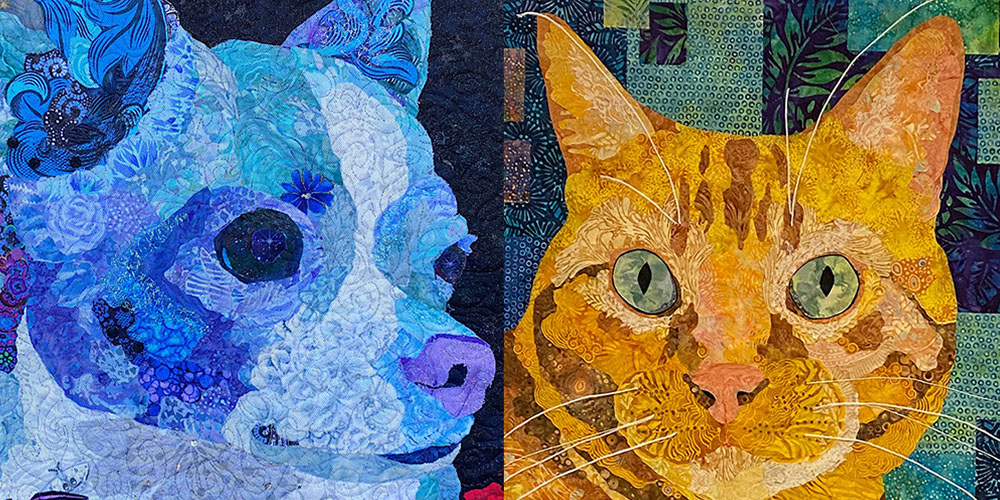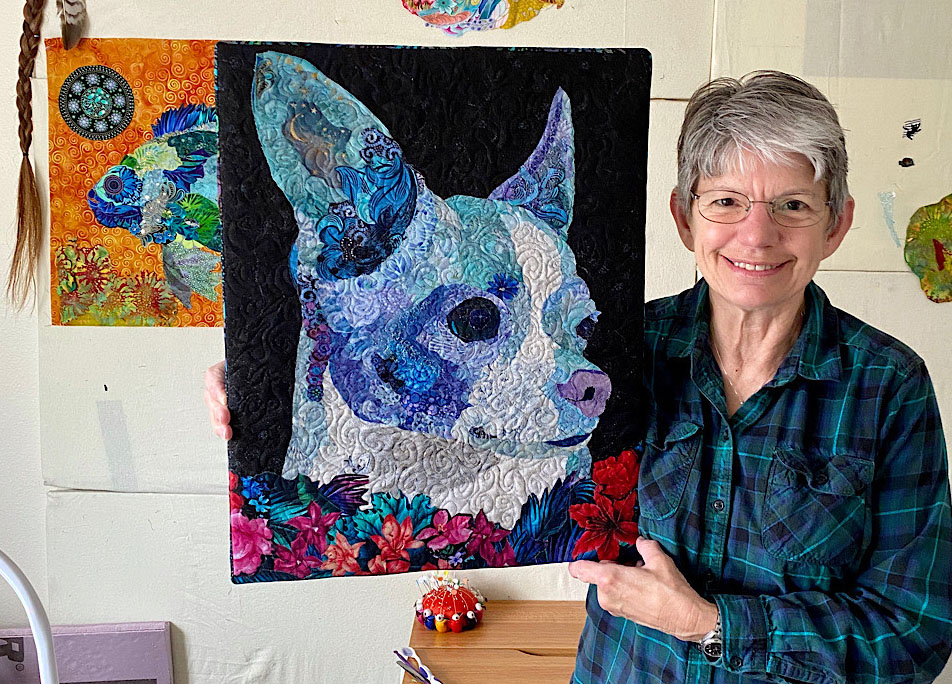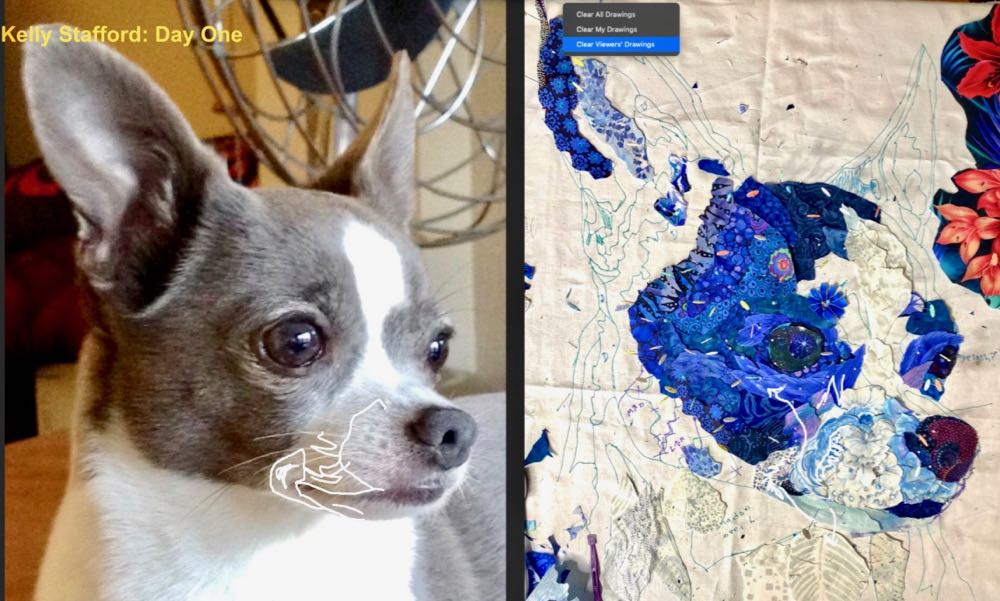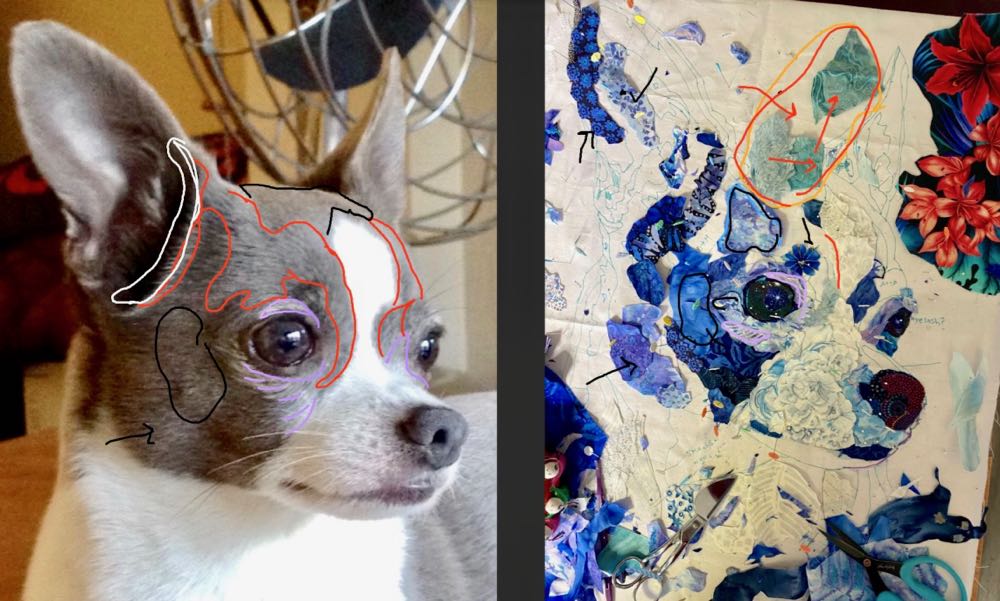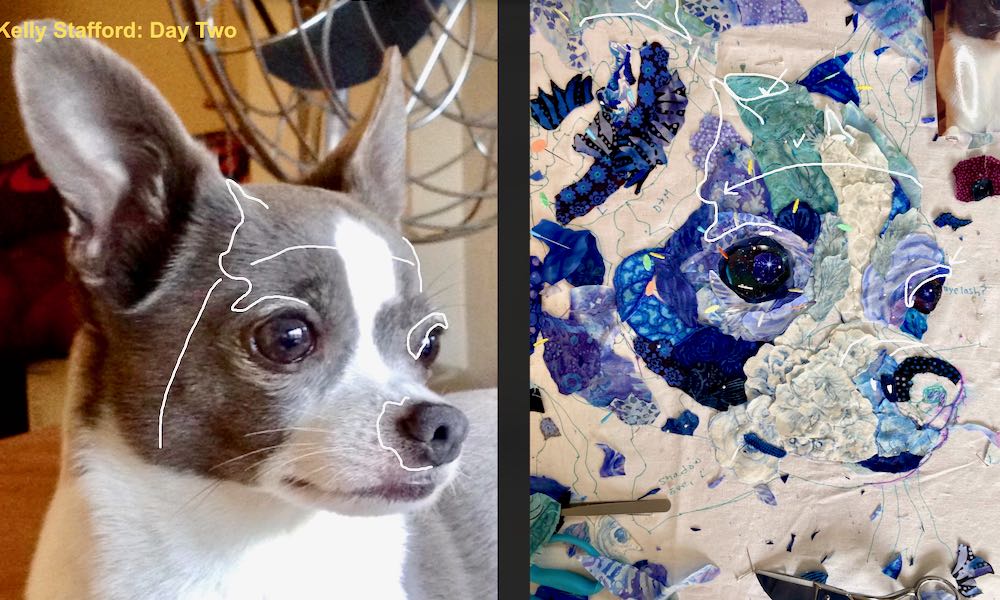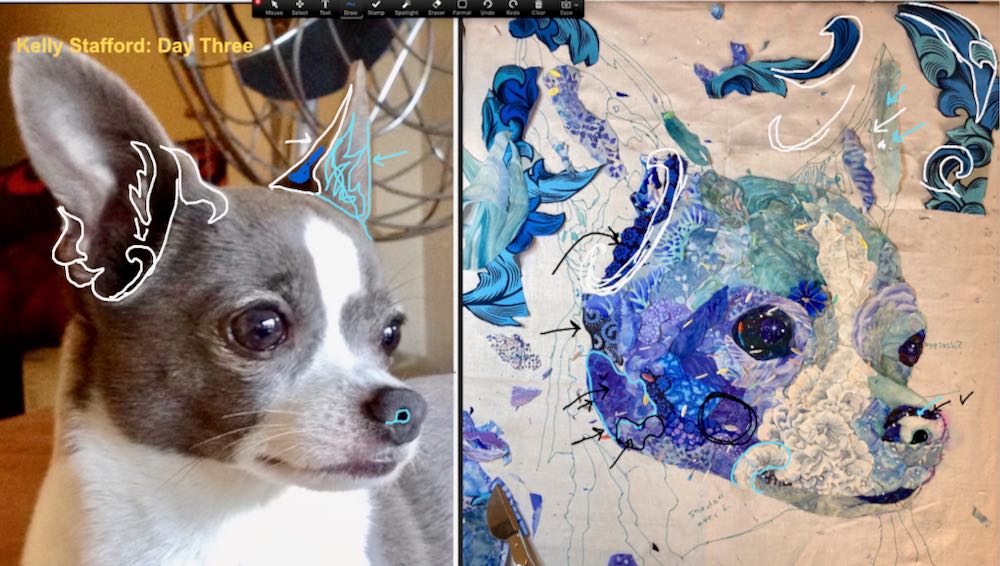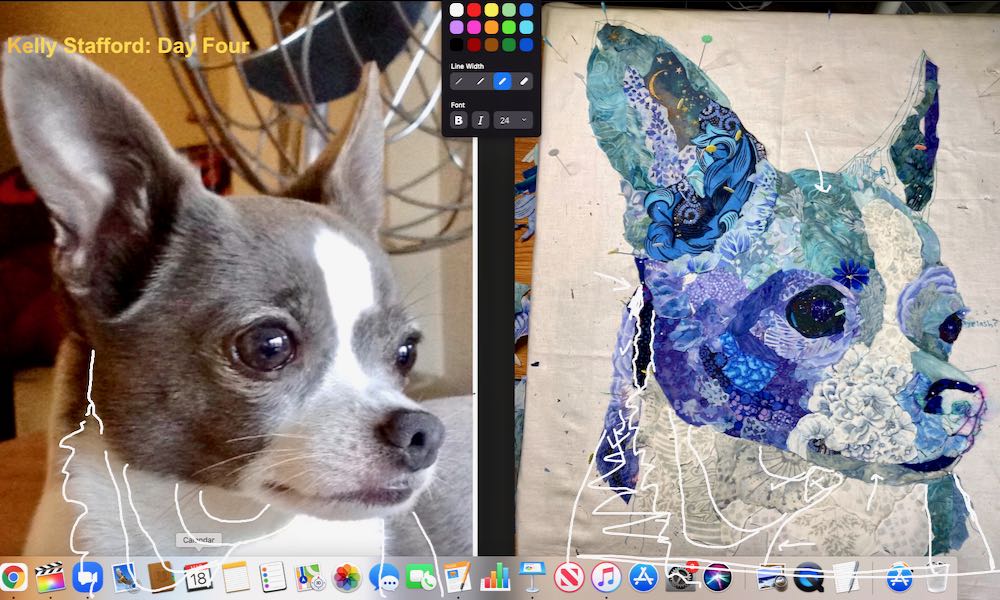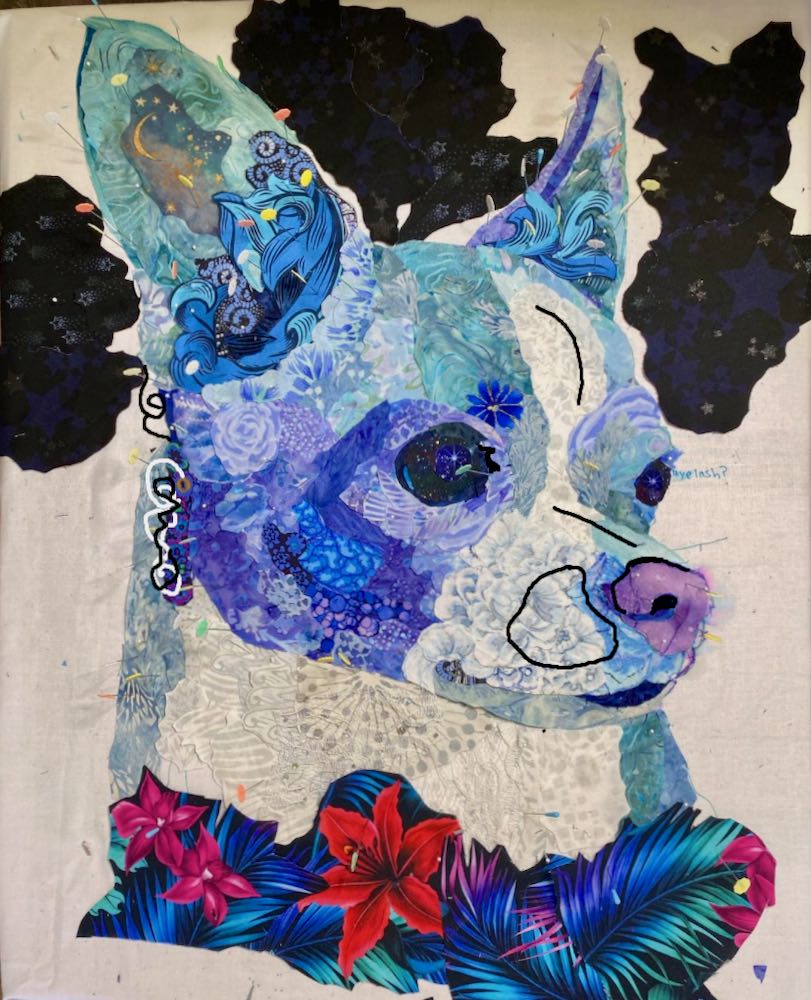The focus for last week and this week’s blog posts have been how Zoom annotation tools can facilitate communication with my online students. Two students from March’s online virtual class, Kelly Stafford and Marie Wood (click here for last week’s post featuring Marie’s work) have granted me permission to use their pet portraits of Roscoe and Ziggy (left to right above), as examples of those photo marking tools that I can use for teaching in this new format. Thank you Kelly and Marie for sharing your work!
An overarching blog post theme for the last month or so is my new live online fabric collage class offerings—three live 5-day classes, three months in a row March through May.
Registration for next week’s April 12-16, class is still possible (below), if you happen to find yourself with five open days to dive right into the class. Just sayin’. The May online class is currently half filled, so there’s a bit more time to consider that one. Live online 5-day classes will be a part of my future teaching schedule, but for the forceable and unpredictable future, they’re now, this month and next month.
I’m loving the online format and weekly schedule Tom and I have put together for these 5-day intensive classes. To check out March’s class click here. And in a couple weeks, we’ll deliver a “NOT on the Road” post about April’s class.
Kelly Stafford and “Roscoe”
I’ve never had the opportunity to meet Kelly in person, but I’ve had the pleasure of working with her through online collage coaching sessions last year on a portrait of her daughter’s horse (below), and earlier this year on a double portrait of her two cats (yet to be finished).
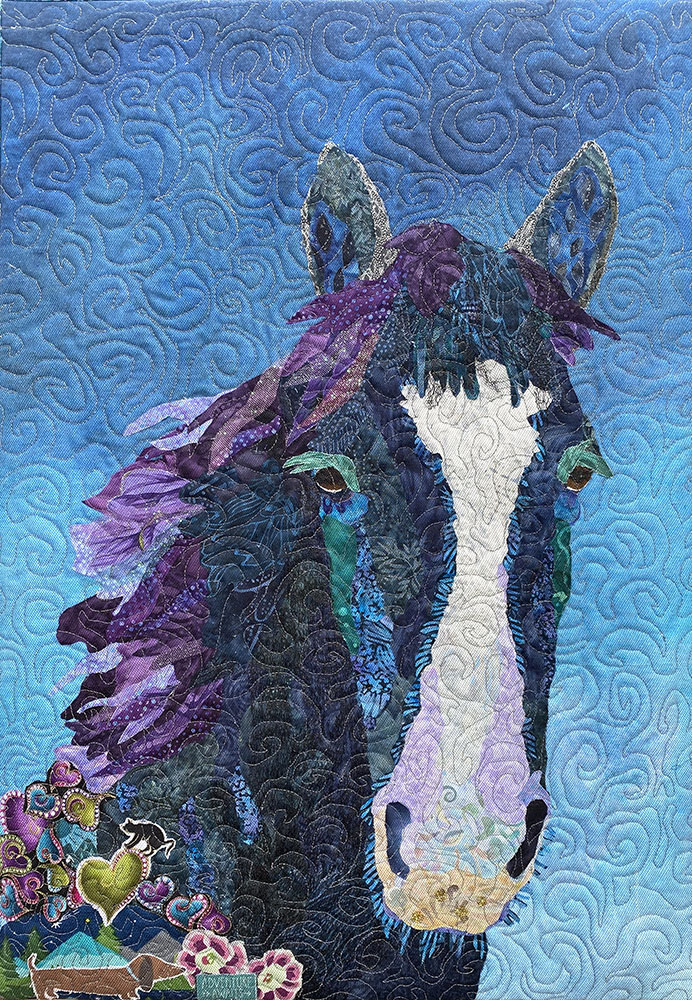
Because of my past experience of working with Kelly, Tom and I assigned her and three other coaching students to their own Zoom breakout room—one of three rooms in our March live online class.
From Kelly:
It was nice having others who had been doing collage for awhile, had experienced coaching, or taken a class. We certainly got a lot done.
Actually, Kelly had already gotten a lot done before Day One of class. The screenshot below is where Kelly started on Monday morning. Her subject, Roscoe the chihuahua, a pet of her daughter’s friend, had recently passed on, and the quilt is a gift to that friend.
Right away, Kelly questioned the dark values of blue on Roscoe’s face. I agreed, they looked a bit dark. When I’m accessing the light and dark values in a piece, I squint my eyes a lot. You can try this too. On Roscoe’s photo, see how his eyes stand out against the soft grey fur around his eyes and muzzle? They’re all but lost on the collage image. And the dark blues on his forehead are placed in an area of lighter fur.
Kelly took the critique very well, I think she was just confirming the observations she had already made, but wanted to make sure before pulling off the fabrics. However, she rose to the task and when I consulted with her later in the afternoon (screenshot below), Roscoe was reinvigorated with a new variety of fabrics in blue to light purple values. But what I was really excited to see was the warm aqua fabrics Kelly had added to her palette, annotated with orange in photo, below right.
I can’t remember our actual conversation, but the orange arrows I drew indicate a progression of values in that new color range, and the outlined orange areas on the photo are indicating areas of value on Roscoe’s fur. I remember we discussed warm versus cool colors—how the blues and purples would work well on the shaded (receding) areas of Roscoe’s face, and the new warm aquas would probably work well on the “sunlit” (forward) areas of his face.
By Day Two (below), Kelly had re-collaged a good portion of Roscoe. We both loved how the aqua fabrics were working to give warmth and dimension to his face, and talked about how far to extend them across his forehead.
From Kelly:
I was a bit exhausted the first 2 days because I rushed myself to try and get as much as possible done before each one-on-one. Once I got to day 3, I was able to relax and enjoy it more.
By Day Three, Kelly was on a roll and had another addition to her fabric palette, the larger print leaves in blue and aqua, see upper right corner of screenshot below. Those kind of bolder prints get me very excited and I thought her idea of using them for the longer fluffy hairs in Roscoe’s ears was a great idea.
In the photos below, you can see Kelly’s progress on those ears. At one point, Kelly said something about enjoying working with that larger print leaf fabric, and it looked like she did when I checked in with her that afternoon. Piece-by-piece, the ears were “emerging” from the foundation fabric.
We laughed at how his front ear appeared so very large in relation to his little head, below right photo. But we both knew that Kelly had done a very nice job with her original drawing—staying true to the photo—so with that in mind, you can relax and trust the process—it’ll all work out in the end. And indeed, once Roscoe’s other ear and neck were collaged, his proportions made sense (for a big-eared chihuahua, that is).
Between Day Three and Four, Kelly moved into Roscoe’s neck area, so that at the beginning of the day we could talk about her fabric choices, highlights and shadows, and the movement of his fur, below. I really liked how Kelly treated the neck area—the “dandelion” half circle in the middle of his chest and the way the rest of the light prints were “flowing out” from it.
By Day Five, Kelly was thinking backgrounds and placed a few cuts of fabric for consideration, below. She told me how Roscoe’s owner loves tropical flowers. I thought that the black star prints made a sharp-looking contrast to the portrait, and seeing as Roscoe was now up in the heavens, seemed appropriate as far as his story went. The fact that the tropical flowers had a black background, would make it easy for Kelly to blend the two elements where the flowers would touch the sky.
There were a couple more fine points to discuss on that last day of class, such as how the area from his ear down to neck would finish up, but I had to congratulate Kelly especially on (finally) solving his nose. It was obviously a relief to her as well since when Tom and I asked in a survey “What was your favorite moment of class?”, Kelly replied “The dog nose demo and my collaged nose looking darn good!” (see dog nose demo time-lapse video here)
I totally agree with Kelly, Roscoe now has a darn good looking nose. So I decided to include a few dog nose close-ups below, of the various iterations and progress Roscoe’s nose made over the course of the five days.
And just a little over a week from the end of class, Kelly emailed us the finished image of Roscoe’s collage quilt portrait, below. What a sweetie. Congratulations, Kelly! Your daughter’s friend has a lovely surprise coming her way.
And just like Marie Wood’s portrait of Ziggy the cat from last week, I had fun looking closely at Roscoe’s finished image to find the additions Kelly had made since I last saw him. She added some netting and tulle for details—to add sparkle on the edges of his ears, to darken the lower curve of his front ear, a highlight on his cheek and a shadow under his neck. I like the moon and star print fabric that found its way to the center of his ear, and the stars that became highlights in his eyes. And if you go back in time, you’ll notice that the blue flower over his eye never strayed off that spot from the very beginning. I love it.
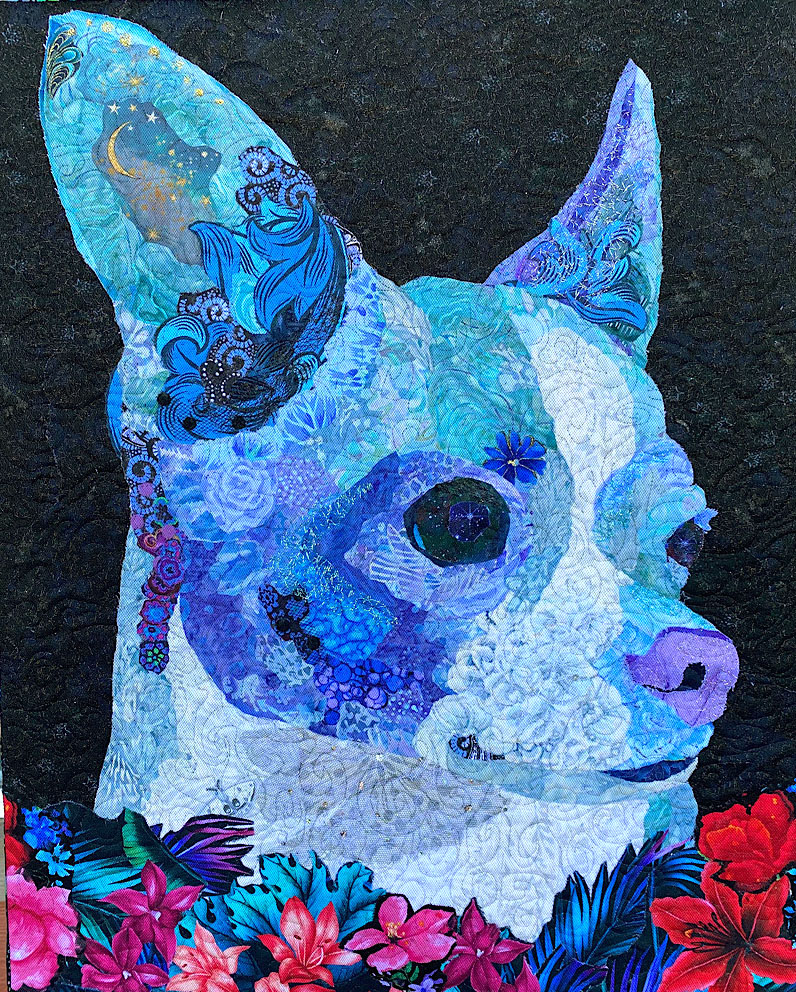
From Kelly:
Overall, I thought this [online class] was very comfortable and I definitely had more access to the instructor. I had full access to all my fabric so when my colors changed, it wasn’t a problem. I’m not a big chatter-er but I felt like I had more social interactions than in other classes.
When asked, “What do you see as the biggest benefit of the online format of this class?” Kelly answered:
Not having to travel. This format allowed me to preserve my energy. I was surprised how much time I was able to put in. I would highly recommend this class to any and all.
